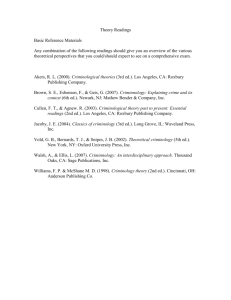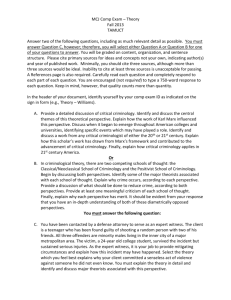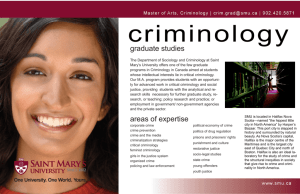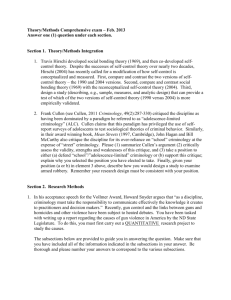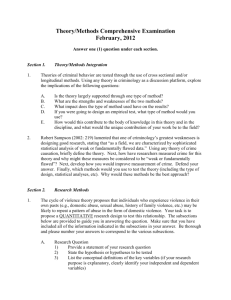THE CURRENT STATE OF NORTH AMERICAN CRITICAL
advertisement
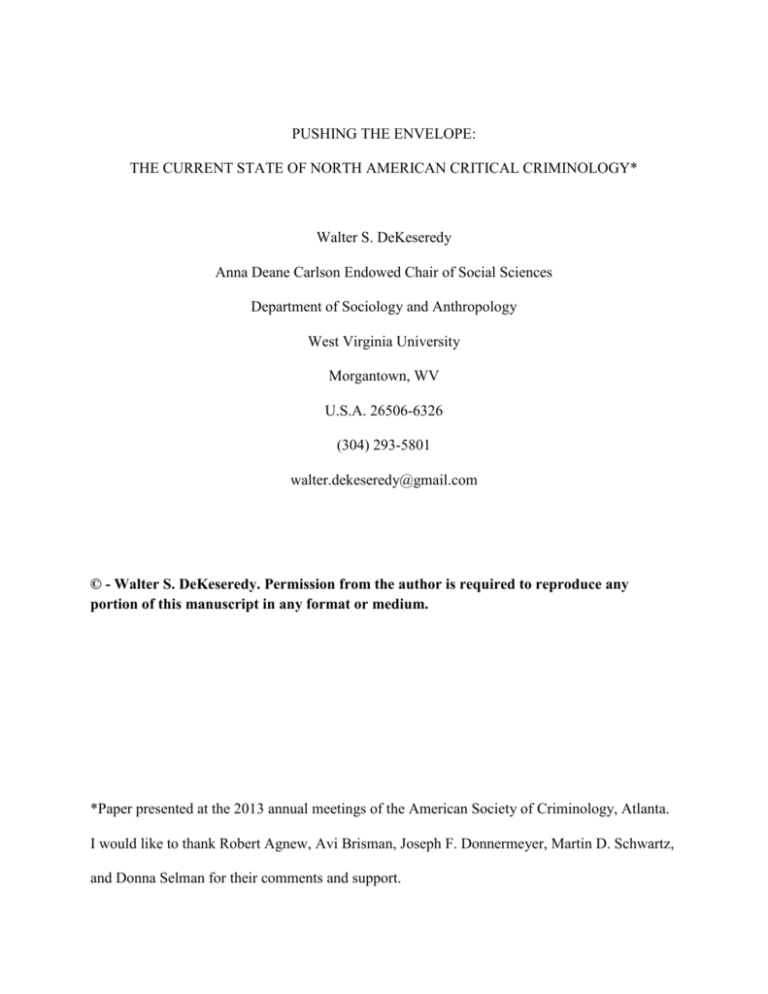
PUSHING THE ENVELOPE: THE CURRENT STATE OF NORTH AMERICAN CRITICAL CRIMINOLOGY* Walter S. DeKeseredy Anna Deane Carlson Endowed Chair of Social Sciences Department of Sociology and Anthropology West Virginia University Morgantown, WV U.S.A. 26506-6326 (304) 293-5801 walter.dekeseredy@gmail.com © - Walter S. DeKeseredy. Permission from the author is required to reproduce any portion of this manuscript in any format or medium. *Paper presented at the 2013 annual meetings of the American Society of Criminology, Atlanta. I would like to thank Robert Agnew, Avi Brisman, Joseph F. Donnermeyer, Martin D. Schwartz, and Donna Selman for their comments and support. ABSTRACT A diverse range of empirical, theoretical, and policy work characterizes North American critical criminology. As well, the various branches of this progressive school of thought continue to flourish and attract a growing number of young scholars. The main objective of this paper is twofold: (1) to review the current state of critical criminological knowledge in the United States and Canada and (2) to articulate some key challenges to be faced by North American progressive scholars in the future. Special attention is devoted to the harms caused by the corporatization of institutions of higher learning throughout the continent. KEYWORDS: critical criminology, theory, North America, education, corporatization 1 Mainstream or orthodox criminologists, especially those based in the U.S., often state that critical criminology is a "borderline field" in the discipline (Gerber, 1993). Further, some prominent mainstream scholars still follow the late James A. Inciardi's (1980) footsteps by portraying progressive offerings to students and others who read their conservative critiques as lacking empirical support and credibility. For example, now in its sixth edition, Akers and Seller's (2013) Criminological Theories: Introduction, Evaluation, and Application repeats the following dated claim featured in earlier renditions of this textbook: "This work does not form a coherent whole that is, a shared body of propositions or generalizations and supporting evidence. Indeed, critical criminology is an intellectual posture around which a variety of criminological endeavors have been pursued" (Gibbons, 1994: 60). Rather than respond in a defensive manner to assertions like this, the main objective of this paper is to review the recent intellectual achievements of North American critical criminologists and to articulate some key challenges they face in the future. Critical criminology, despite constantly being subjected to conservative attacks, is both flourishing and making a major scholarly impact around the world. BEYOND "MALESTREAM" CRITICAL THINKING In the early 1970s until the late 1980s, critical criminological thought on both sides of the North American border was dominated by men primarily informed by Marxist theory. Some widely cited names that immediately come to mind are William Chambliss (1973, 1975, 1988), Ian Taylor (1983),1 David Greenberg (1976, 1981), Stephen Spitzer (1975), Brian MacLean (1986), Thomas Fleming (1985), Ronald Hinch (1985), and Colin Goff and Charles Reasons (1978). Collectively, their work, albeit path-breaking at the time, is, as has been repeatedly stated, "gender-blind" (Gelsthorpe and Morris, 1988). In the mid- to late 1980s, however, as 1 The late Ian Taylor was one of the most powerful influences on North American critical criminology. He spent most of the 1980s (1982-89) in Canada at Carleton University his impact on Canadian progressive sociological thought is still felt today (DeKeseredy, 2012). 2 Michalowski (2012: 20) recalls in his historical account of critical criminology in the U.S., "a number of newer anti-criminologists, particularly feminists, were challenging the dominant order from frameworks that were not expressly (or exclusively) Marxist or political-economic in nature." This is one of the key reasons why the term "radical criminology" was replaced with "critical criminology," which is, in the words of Michalowski, "a bigger theoretical tent." Similarly, in the late 1980s in Canada, a group of scholars scattered across the country attempted to break with the hegemony of Marxist thought (especially U.S. and British traditions) and create a bigger theoretical tent that moves feminism from the margins to the forefront of progressive thought. Born in 1989, the Human Justice Collective (HJC) included prominent Canadian feminists such as Dawn Currie, Laureen Snider, Elizabeth Comack, Shelly Gavigan, and Elizabeth Sheehy. Unfortunately, major conflicts between two HJC members based at the same institution, and with one of them denied reappointment at this school, contributed to much tension within the Collective (DeKeseredy, 2012a). Ratner (2006: 653) recalls, "News of the disaffection spread quickly, people took sides, and, for many, the collective became an embattled site or sour memory." The HJC disbanded in 1995, but during that same year the American Society of Criminology's (ASC) Division on Critical Criminology adopted the Collective's journal (Journal of Human Justice) and it is now called Critical Criminology: An International Journal. Feminists played a major role in the creation of the DCC, and its first Chair was feminist scholar Susan Caringella (Michalowski, 1996). Since her tenure as Chair (1989-90), feminist scholars and women who embrace other progressive theoretical positions from across the continent hold major executive positions in the DCC, with some of them serving as Chairs 3 (Meda Chesney-Lind, Dawn Rothe, and Donna Selman) and holding other important positions, such as co-editors of the DCC newsletter The Critical Criminologist.2 In sum, gender- and sex-related issues are no longer excluded in North American critical criminology and in progressive criminological circles situated in other parts of the world, such as Australia and the United Kingdom (Carrington and Hogg, 2012; Gelsthorpe, 2013). Consider that only two of the 20 chapters in Fleming's (1985) Canadian anthology The New Criminologies in Canada are authored by women. More recently, edited by DeKeseredy and Dragiewicz (2012) while they were living in Canada,3 the Routledge Handbook of Critical Criminology includes 38 chapters and 19 contributors are women. Not all of these women are based in North America, but the vast majority are. Nevertheless, gender and sexuality issues do not always receive equal treatment in critical North American books and journals. Consider that Doyle and Moore's (2011a) anthology Critical Criminology in Canada includes only one chapter on feminist criminology (Balfour, 2011), which is a revised version of a previous publication. This is not to say, however, that there is not a vibrant group of Canadian feminist criminologists. To be sure there is, but the voices of this cohort's gendered analyses of social problems warrant much more scholarly attention from Canadian mainstream and progressive criminologists alike. After all, feminism is widely recognized as a key variant of critical criminology and the journal Feminist Criminology is one of the most important periodicals in the field.4 2 Currently, Emily Troshynski, Travis Linneman, and Kate Henne are Co-Editors of The Critical Criminologist. Molly Dragiewicz and Walter DeKeseredy were affiliated with the University of Ontario Institute of Technology in Oshawa, Ontario, Canada. Dragiewicz joined Queensland University of Technology in the summer of 2013 and DeKeseredy departed for West Virginia University roughly six months later. 4 Not all feminist criminologists agree with the view that feminist criminology is a type of critical criminology. According to Chesney-Lind and Morash (2013: 2), "In our view, that is not really an accurate depiction, since not all critical criminologists place gender at the center of theory, and not all feminist criminologists see their work as part of the broader struggle for social justice." 3 4 Feminism has shaped North critical criminological thought in many ways, one of which is the development of a relatively new direction in critical criminology - masculinities studies. The study of masculinities is the gendered study of men (Morgan, 1992) and no other North American scholar has made a bigger impact on a gendered understanding of men's involvement in crime than James Messerschmidt (1993, 2014). On top of motivating criminologists to pay more attention to "maleness" and its relationship to crime, masculinities theorists such as Messerschmidt and Mullins (2006) draw attention to how the intersection of race/ethnicity, class and gender shape men's involvement in crime (DeKeseredy, 2011; Lilly, Cullen, and Ball, 2011). It is refreshing to witness the recent publication of an article on masculinties and crime in Criminology (see Carlsson, 2013), which is one of two official journals of the ASC and is sharply criticized in progressive intellectual arenas for its long history of marginalizing critical criminological theory and research (DeKeseredy, 2012b). Although the word "feminist" is frequently in this paper and scores of other publications, it cannot be emphasized that there different feminist ways of knowing in critical criminology (Renzetti, 2012), but it is beyond the scope of this paper to briefly describe the various feminist schools of thought.5 The most important point to keep in mind here, however, is that, from a broad range of feminist standpoints, within critical criminology, "There is no doubt that things have changed - and for the better...." (Renzetti, 2013: 2). Still, things could be even better. "GOING UP THE COUNTRY"6 Criminology in general has an urban bias (DeKeseredy and Donnermeyer, 2013). This is somewhat ironic because rural communities are not less criminogenic than urban areas (Donnermeyer and DeKeseredy, 2014), a discovery that challenges conventional wisdom. In 5 See Renzetti (2013) for in-depth reviews of feminist perspectives in criminology. This heading is the title of a song featured on U.S. blues-rock band Canned Heat's record Living the Blues. It garnered a large audience after the band performed it at the Woodstock music festival in August 1969. 6 5 truth, rural rates may be higher than urban rates in particular types of rural places and for specific kinds of crime (Donnermeyer, 2012). For example, using National Crime Victimization Survey (NCVS) data, Rennison, DeKeseredy, and Dragiewicz (2012) found that rural separated/divorced women were markedly more likely to be sexually assaulted than urban women. Nevertheless, until the creation of feminist male peer support theories (See DeKeseredy, Donnermeyer, Schwartz, Tunnell, and Hall, 2007; DeKeseredy, Rogness, and Schwartz, 2004), rural research on woman abuse was underdeveloped theoretically. The same can be said about any type of North American rural crime research and what did exist prior to these integrated theories was dominated by place-based perspectives, such as social disorganization theory (Donnermeyer and DeKeseredy, 2014). There is now an emergence of critical criminological scholarship on drug use, woman abuse, racism, and other social problems that plague rural areas in Canada, the United Kingdom, the U.S., Australia, and elsewhere. Gagne's (1992, 1996) feminist work on woman abuse played an important role in sparking contemporary critical interpretations of rural crime and social control.7 Shortly after came Websdale's (1998) Rural Woman Battering and the Justice System: An Ethnography. Nevertheless, the flames did not emerge until the latter part of the last decade with the publication of a spate of scholarly books, journal articles, and chapters,8 many of which continued along the path broken by Gagne and Websdale. The aforementioned feminist male peer support theories are among the group of critical perspectives that departed from "criminological and sociological urbanism" (Hogg and Carrington, 2006: 1). Developed shortly after were attempts by DeKeseredy and Donnermeyer (2013) and Donnermeyer and DeKeseredy 7 Some people claim that Chambliss (1964) was the first critical criminologist to do rural research (Coventry and Palmer, 2008; DeKeseredy and Donnermeyer, 2013). 8 See DeKeseredy and Donnermeyer (2013) and Donnermeyer and DeKeseredy (2014) for reviews of these offerings. 6 (2008) to develop a new left realist perspective on rural crime, and they eventually partnered with cultural criminologist Stephen Muzzatti to examine the media's horrification and pornification of rural culture (See DeKeseredy, Muzzatti, and Donnermeyer, 2013). Hopefully, scholars associated with other ways of thinking critically about crime (e.g., peacemaking criminology, postmodernism, etc.) will add to the critical rural literature briefly reviewed here. There is much more work to be done and rural communities are fertile places for doing "cutting-edge" progressive empirical, theoretical, and policy work. INTERPERSONAL VIOLENCE It may seem counterintuitive to state that interpersonal violence is a new area of critical criminological inquiry in North America and elsewhere. Still until relatively recently, such crime was not extensively examined by critical criminologists. Some salient exceptions are studies of woman abuse done by feminists, left realists, and masculinities scholars. Masculinities and left realist research also focuses on predatory street crimes and hate crimes (DeKeseredy, 2011; Friedrichs, 2009; Mullins, 2006; Perry, 2003). Still, other critical schools of thought have paid little attention to such issues. The rationale for doing so is rooted in the early Marxist criminological tradition of challenging state definitions of crime and responding to orthodox criminologists neglect to study crimes of the powerful and how the criminal justice system perpetuates and legitimates class inequality, gender inequality, and racism (Matthews, 2012). To the best of my knowledge, there are only three recent North American critical criminological textbooks on violent crime in general (Barak, 2003; Brownstein, 2000; Currie, 2009).9 The vast majority of critical criminological books and articles on violence address the above topics (e.g., woman abuse) and hence there is ample room for new critical directions in 9 Albeit not a textbook per se, Elliott Currie's (1985) Confronting Crime: An American Challenge was the arguably the first critical criminological book on violent crime in the U.S. and was adopted in many undergraduate courses across North America. 7 understanding interpersonal violence in Canada and the U.S. Still, it is important to note that there are scholars who do not identify themselves as criminologists of any sort but who are doing what many would define as critical criminological empirical and theoretical work on violence. Consider the in-depth studies of pornography done by Gail Dines (2010) and Robert Jensen (2007). The former is a professor of sociology and women's studies and the latter is a journalism scholar. Additionally, though not generally defined as interpersonal violence, some feminist scholars gather quantitative and qualitative data on offenses that cause just as much, if not more, harm than nonlethal acts of physical violence such as punching and choking. Consider sexual harassment in public and private places and coercive control in intimate heterosexual relationships. Coercive control frequently involves psychologically and emotionally abusive behaviors that are often subtle, hard to detect and prove, and seem to be more forgivable to people unfamiliar with the abuse of women and its consequences (DeKeseredy and Schwartz, 2013a). The main goal of coercive control is to restrict a woman's liberties (Tanha, Beck, Figueredo, and Raghavan, 2010), and two prime examples are threatening looks and criticism (Kernsmith, 2008). Thousands of men also use other coercive control tactics to suppress their intimate partner's personal freedom, including "microregulating a partner's behavior" (Stark, 2007: 229). This, then, is another reason why many feminist and other critical scholars assert that we should develop and operationalize even broader definitions of interpersonal violence. SEEING GREEN The world is experiencing a myriad of environmental harms, but as Avi Brisman and Nigel South (2013: 2) correctly point out, "For too long, criminology stood on the sideline, leaving the study of environmental crime, harm, law, and regulations to researchers in other 8 fields (Lynch and Stretesky, 2003: 231)." Things have definitely changed and critical criminologists in North America and elsewhere now produce a wealth of what Brisman and South refer to as "green criminological scholarship." What is green criminology? It would be surprising if defining this school of thought was not the subject of debate. Following Brisman and South (2013: 2), it is referred to as "the term that criminologists most frequently employ to describe the exploration and examinational of causes of and responses to 'ecological,' 'environmental," or 'green' crimes, harms, and hazards." There is so much critical work done on green issues that South and Brisman (2013) coedited the Routledge International Handbook of Green Criminology. U.S. critical criminologist Michal J. Lynch (1990) published an article in The Critical Criminologist which was, as Brisman and South (2013: 3) put it, "the springboard for much of the research on environmental harm and crime in the last 20 years." As is the case with cultural criminology, critical green scholarship involves doing collaborative work with an international body of academics and Brisman and South are major examples of scholars based in different continents10 who routinely team up to generate new empirical and theoretical work on green issues. One of their latest efforts is the creation of a "green cultural criminology" (see Brisman and South, 2014). They merge green criminologists' concerns with cultural criminology's concern with "culture" and compel cultural criminologists to adopt green scholars' view of the "consumption landscape" and the proliferation of environmental harms. The concerns of green criminologists also merge with some rural critical criminologists' interests, such as agricultural crime (Donnermeyer and DeKeseredy, 2014). For instance, DeKeseredy and Donnermeyer's (2013) left realist perspective on rural crime shows that not all agriculturalists look alike, and challenges various agrarian fundamentalist notions of farming as a 10 Brisman is based at Eastern Kentucky University and South is at the University of Essex in the United Kingdom. 9 benign enterprise and farmers as caretakers of the land. In many countries, agriculture is a hightech, capital-intensive, multi-billion dollar industry. The vested interest of farm operators (and agricultural industries) to achieve efficiency and profit through various practices - from the use (and overuse) of farm chemicals and genetically modified organisms (Donnermeyer, 2012; Walters, 2006) to the pollution of water or wetlands with effluent from dairies, irrigated pastures or grazing livestock - are part of DeKeseredy and Donnermeyer's left realist discourse on agricultural crime. Contrary to what Doyle and Moore (2011b) suggest, left realism today is not strictly tied to British Labour Party politics during the Margaret Thatcher years. Nor is this school of thought decidedly urban and restricted to the focus on predatory street crime and violence against women. Rural left realism explicitly recognizes that there is much to be learned from green criminology, as there is from cultural criminology. The work of DeKeseredy et al. (2013) on media's horrification and pornification of rural culture exemplifies this point. Left realists (e.g., Matthews, 2014) too, are embracing cultural criminology. Left realism's engagement with cultural criminology is not surprising for reasons articulated by Jock Young (2013: xxxvii) in his introduction to the 40th anniversary edition of Taylor, Walton, and Young's (1973) The New Criminology. One of which is that "[C]ultural criminology brings to the square of crime meaning, energy and emotion: it turns its formal structure into a lived reality." The square of crime was developed by British left realists in the early 1990s. It consists of four interacting elements: victim, offender, police and agencies of the state, and the public. Young (1992: 27) describes the social relationships between each point on the square: It is the relationship between the police and the public which determines the efficacy of policing, the relationship between the victim and offender which determines the impact 10 of crime, the relationship between the state and the offender which is a major factor in recidivism. If the square of crime is compatible with cultural criminology, Donnermeyer and DeKeseredy (2008, 2014) show that it is also relevant to a critical criminological understanding of criminal activities and social control in rural communities, including agricultural and other rural green crimes. Donnermeyer and DeKeseredy (2014) use the square of crime to summarize existing rural crime literature, to identify linkages of the micro and the macro, and to show possible avenues for future research. However, they do not claim that the square of crime is a general critical framework accounting for all factors, micro and macro, which would help scholars understand crime in the rural context. A diversity of critical criminology perspectives have yet to be applied to rural criminological issues, but it is assumed that other progressive criminologists will soon apply their own frameworks, models, and theories. THE USUSAL SUSPECTS11 North American critical criminology has a long history of focusing on crimes of the powerful, media constructions of crime, the "penal state" (Garland, 2013), women and girls in conflict with the law, drugs, gangs, policing, and progressive alternatives to the draconian criminal justice system.12 Even so, the work on these issues never goes stale. As the world changes, so do the theories and research methods used by progressive scholars. Similarly, new policy proposals aimed at curbing the "usual suspects" are continually advanced. For example, Walter DeKeseredy and Martin D. Schwartz have studied pornography for nearly twenty years, but their policy proposals have changed due to the emergence of the Internet. We know live in what Jensen (2007) refers to as a "post-Playboy world" in which pornographic media is 11 This is the title of a popular 1995 Hollywood movie. See DeKeseredy and Dragiewicz (2012) for recent in-depth reviews of the critical criminological literature on these topics. 12 11 dominated by "gonzo - that genre which is all over the Internet and is today one of the biggest moneymakers for the industry - which depicts hard-core, body-punishing sex in which women are demeaned and debased" (Dines, 2010: p. xi). In response to this contemporary problem, DeKeseredy and Schwartz (2013a) call for boycotting hotels and stores that offer "adult videos." "Newsmaking criminology," too, has a relatively long history in critical criminological circles, but it also takes new shapes and forms. This approach is defined as the "conscious efforts of criminologists and others to participate in the presentation of 'newsworthy' items about crime and justice" (Barak, 1988: 565). Today, instead of relying primarily on orthodox media (e.g., newspapers) to disseminate their progressive messages, critical criminologists, like their conservative counterparts, also use blogs, websites, social media, and other electronic resources. Some critical criminologists use other innovative means of "getting the message out." For example, since new technologies are used to play and listen to music, Kauzlarich (2014) and Kauzlarich and Awsumb (2012) show that oppositional variants of this art form can challenge crimes of the powerful, such as state oppression. CHALLENGES FOR THE FUTURE In North America and other places, critical criminology is not "essentially the same beast today as it was in the early 1970s" (Winlow and Atkinson, 2013: 2). Still, it is "always in need of new direction" (Hayward, 2012: 142). Where do we go from here? There are many answers to this question, but all of them cannot be included in this paper. To be sure, other progressives will continue to add to the recommendations briefly included here, one of which is expanding on Indigenous ways of knowing. Race and ethnicity have long been subjects of North American critical criminological inquiry, but there is very little progressive theoretical, empirical, and policy work on social problems experienced by Indigenous populations (DeKeseredy and 12 Dragiewicz, 2014). Actually, criminology in general has not done much to describe their plight and to help their struggle for change (DeKeseredy and Schwartz, 2013b). If truth be told, as Maori scholar Juan Marcellus Tauri (2013) notes, most criminological work on Indigenous issues has done more harm than good. There is much crime, especially violence against women and children, in Indigenous communities. For example, only about 3% of the 35 million Canadian residents identify themselves as Aboriginal, but it is estimated that they are 12.5 times more likely to be victims of robbery or of physical or sexual assault than non-Aboriginal people (Perreault, 2011; Siegel and McCormick, 2012). Most of the crimes committed by Canadian Aboriginal people, though, are "native-on-native" and their key correlates are overcrowded housing, poverty, major health problems, and lack of adequate social services (Donnermeyer and DeKeseredy, 2014). Nevertheless, crime and other harms experienced by Indigenous communities cannot be adequately addressed without a thorough, sophisticated understanding of colonialism. It is defined here as "the systematic oppression of people through a variety of assimilationist measures that are intended to eradicate the peoples and/or their sense of individual and cultural identity" (Restoule, 2009: 272). If, as Cowlishaw (2013: 245) observes, "crime is an everyday matter" in Indigenous communities, the same can be said about "over policing" and other racist criminal justice practices (Perry, 2009). Certainly, it is time for the development of an Indigenous critical criminology that prioritizes the voices and experiences of First Nations people. The last sentence of Tauri's (2013: 229) piece is so meaningful that it is repeated here: "[I] never fail to be surprised by the silence that emanates from Authoritarian Criminology to our simple refrain: 13 'why is so much of this criminological work carried out on our behalf, but without the necessary engagement with our communities'." All of the chapters in Renzetti, Miller, and Gover's (2013) Routledge International Handbook of Crime and Gender Studies illustrate that feminist research on gender and crime is rapidly expanding and evolving. Still, gaps in the literature remain, such as the dearth of feminist scholarship on state crime, new technologies, the state, and conservative evidence-based practice (DeKeseredy and Dragiewicz, 2013). Undoubtedly, feminist readers will point to topics excluded here and address them in their own work. Other theoretical, empirical, and policy issues warrant more critical criminological attention in North America and around the globe, including revisiting the political economy of crime (Reiner, 2012), new ways of thinking about corporate crime (Burdis and Tombs, 2012), and integrating political economy into cultural criminology (Ferrell, 2012). However, many readers will disagree with my interpretation of the current state of North American critical criminology. This is all to the good, and as Ellis (1987: p. xiii) notes in his commentary on the categorization of deviance theories, "Here, as elsewhere, there is a lot of room for differences in judgement." To be sure, what makes critical criminology so exciting are the ongoing and ever changing theoretical, empirical, and political debates. Perhaps one of the greatest challenges facing North American critical criminologists today is the corporatization of institutions of higher learning (DeKeseredy, 2013a, 2013b; Jacobs, 2005). This is not to say, though, that this problem is not negatively affecting non-critical criminologists and scholars affiliated with other disciplines (e.g., biology, chemistry, etc.). Even so, the "soft sciences," such as those based in the social science and humanities departments are at much great risk of being gutted or radically reformed. For example, directly related to the 14 corporatization of North American universities is the surfacing of administrative or applied criminology programs modeled after conservative criminal justice programs offered at U.S. institutions of higher learning (Cote and Allahar, 2011; DeKeseredy, 2012b). One more example of the attack on the social sciences and humanities is this statement made by member of Provincial Parliament John Milloy, Ontario's former Minister of Training, Colleges and Universities in his announcement about funding 6,000 more M.A. and Ph.D. students in the next few years: We're not saying 'no to any more master's programs in history or the humanities, but we want to look at high-demand programs that make sense - engineering, health, environmental studies are examples - and programs that mesh with our research priorities as a province (cited in Brown, 2011: A10). Possibly, given funding schemes like the above, criminology schools and departments will become even more conservative and positivistic in nature. Undeniably, broader political economic forces help shape theoretical development and many scholars will "go where the money is" to preserve their jobs and/or to get external support for their research. This was always the case in the academy, regardless of who was in charge of educational funding and government research agencies. Also, North American criminological thought has, for a very long time, been dominated by orthodox views (DeKeseredy, 2012b). Critical criminologists are deeply committed to policy development and praxis, but they are also deeply immersed in academic projects that are "becoming more marginalized and irrelevant" (Matthews, 2009: 341). Critical criminological theory development and critical thinking are also being undermined in classrooms. For example, North American universities are aggressively pressuring criminological programs to prioritize teaching practical skills over theory 15 (Huey, 2011). Sadly, there is much public support for this approach and for the marginalization and gutting of the humanities and social sciences. Related to this is the problem that aggressively "lowering higher education" is one of the key reasons why conservative politicians get elected (Cote and Allahar, 2011; DeKeseredy, 2011). Furthermore, scores of people view criminological theories as impractical or irrelevant (Akers and Sellers, 2013), a view shared by many students and supported by conservative, corporate-minded administrators. To make matters worse, given these people's disrespect for theories, faculty who teach them, particularly if they are critical criminologists, are a great risk of receiving negative teaching evaluations, which, in turn, jeopardizes their tenure and promotion (Dupont, 2011). The key reason for the assault on the arts and humanities is that they promote critical thinking and motivate students to question the legitimacy neoliberal status quo. In Canada, for example, conservative's contempt for the liberal arts is long-standing. Note that after a 25% budget cut to Ontario universities in the 1990s, Progressive Conservative Premier Mike Harris referred to sociology as a useless discipline that universities should cut. Current Canadian Prime Minister Stephen Harper and his colleagues also dislike sociology, but they have a bigger problem with criminologists, many of whom are trained in sociology (DeKeseredy, 2013a). Harper labels them "ivory tower experts" who are part of society's crime problem. He also said that criminologists "are not criminals themselves, but who are always making excuses for them, and when they aren't making excuses, they are denying that crime is even a problem" (cited in Heath, 2013: 1). Many more examples of the harm done by the corporatization of North American universities and colleges could easily be presented here.13 Certainly, the academy is "a more 13 See Cote and Allahar (2011) and DeKeseredy (2012, 2013a,) for more in-depth accounts of the corporatization of North American institutions of higher learning. 16 conservative place" (Bove, 2013). And, in Canada, "hostility to expertise in all of its forms is the closest thing that Canadian conservatives have to a unifying ideology" (Heath, 2013: 1). Yet, critical criminologists are not banding together to challenge threats to their intellectual and political well-being (Huey, 2011; Israel, 2000), and the end result could be a type of academic apartheid or intellectual proletarianization (DeKeseredy, 2012b). What, then, is to be done? Space limitations preclude detailed answers to this question. In spite of this, one suggestion is necessary here. While there may never be a unified criminology as called for by Agnew (2011), despite their ideological differences, it is time for critical criminologists and liberal mainstream scholars to form a treaty to collectively struggle to ensure that academic criminology remains a core part of higher learning. As Doyle and Moore (2011b: 5) remind us, "shouting down" proponents of strain, subcultural, ecological, and other liberal orthodox theories "tends strongly to drive wedges between positions that are not that far apart, so that people who really have a lot in common end up instead fighting about relatively small differences." In this current political economic context characterized by a rabid conservative attack on the liberal arts and humanities, "we need all the friends we can get" and critical criminologists should join forces with their more progressive-minded mainstream colleagues to ward off attempts to turn universities and colleges into non-academic training grounds for future agents of social control. Maybe, then, academic criminology will eventually become a lessdivided discipline. 17 REFERENCES Agnew, Robert. 2011. Toward a Unified Criminology: Integrating Assumptions About Crime, People, and Society. New York: New York University Press. Akers, Ronald L., and Christine S. Sellers. 2013. Criminological Theories: Introduction, Evaluation, and Application, 6th ed. New York: Oxford University Press. Balfour, Gillian. 2011. Reimagining a feminist criminology. In Critical Criminology in Canada: New Voices, New Directions, eds. Aaron Doyle and Dawn Moore. Vancouver, BC: University of British Columbia Press. Barak, Gregg. 1988. Newsmaking criminology: Reflections on the media, intellectuals, and crime. Justice Quarterly 5:565-588. Barak, Gregg. 2003. Violence and Nonviolence: Pathways to Understanding. Thousand Oaks, CA: Sage. Bove, Paul A. 2013. A More Conservative Place: Intellectual Culture in the Bush Era. Hanover, NH: Dartmouth College Press. Brisman, Avi, and Nigel South. 2013. Introduction: Horizons, issues and relationships in green criminology. In Routledge International Handbook of Green Criminology, eds. Nigel South and Avi Brisman. London: Routledge. Brisman, Avi, and Nigel South. 2014. Green Cultural Criminology: Constructions of Environmental Harm, Consumerism, and Resistance to Ecocide. London: Routledge. Brown, L. 2011. Ontario to fund 6,000 more post-grad degrees: Focus will be on fields in high demand, such as engineering, health. Toronto Star June 8:A10. Brownstein, Henry H. 2000. The Social Reality of Violence. Lanham, MD: Roman & Littlefield. Burdis, Kate, and Steve Tombs. After the crisis: New directions in theorizing corporate and white-collar crime. In New Directions in Criminological Theory, eds. Steve Hall and Simon Winlow. London: Routledge. Carlsson, Christopher. 2013. Masculinities, persistence, and desistance. Criminology 51:661694. Carrington, Kerry, and Russell Hogg. 2012. History of critical criminology in Australia. . In Routledge Handbook of Critical Criminology, eds. Walter S. DeKeseredy and Molly Dragiewicz. London: Routledge. Chambliss, William J. 1964. A sociological analysis of the law of vagrancy. Social Problems 12:67-77. 18 Chambliss, William J. 1973. The saints and roughnecks. Society 11:22-31. Chambliss, William J. 1975. Toward a political economy of crime. Theory and Society Summer:167-180. Chambliss, William J. 1988. On The Take. Bloomington: Indiana University Press. Chesney-Lind, Meda, and Merry Morash. 2013. Transformative feminist criminology: A critical re-thinking of a discipline. Critical Criminology DOI 10.1007/s10612-013-9187-2. Cote, James E., and Anton L. Allahar. 2011. Lowering Higher Education: The Rise of Corporate Universities and the Fall of Liberal Education. Toronto: University of Toronto Press. Coventry, Gary, and Darren Palmer. Toward constituting a critical criminology for rural Australia. In The Critical Criminology Companion, eds. Thalia Anthony and Chris Cunneen. Sydney, AU: Federation Press. Cowlishaw, Gillian. 2013. Reproducing criminality: How cure enhances cause. In Crime, Justice and Social Democracy: International Perspectives, eds. Kerry Carrington, Matthew Ball, Erin O'Brien, and Juan Marcellus Tauri. New York: Palgrave Macmillan. Currie, Elliott. 2009. The Roots of Danger: Violent Crime in Global Perspective. Saddle River, NJ: Prentice-Hall. DeKeseredy, Walter S. 2011. Contemporary Critical Criminology. London: Routledge. DeKeseredy, Walter S. 2012a. History of critical criminology in Canada. In Routledge Handbook of Critical Criminology, eds. Walter S. DeKeseredy and Molly Dragiewicz. London: Routledge. DeKeseredy, Walter S. 2012b. The current condition of criminological theory in North America. In New Directions in Criminological Theory, eds. Steve Hall and Simon Winlow. London: Routledge. DeKeseredy, Walter S. 2013a. Crime, justice, and inequality: Oh Canada, where art thou? International Journal for Crime, Justice and Social Democracy 2:1-15. DeKeseredy, Walter S. 2013b. Welcome to the dark side: Some thoughts on the challenges of being an early progressive scholar. The Criminologist 38:44-45. DeKeseredy, Walter S., and Joseph F. Donnermeyer. 2013. Thinking critically about rural crime: Toward the development of a new left realist perspective. In New Directions in Crime and Deviancy, eds. Simon Winlow and Rowland Atkinson. London: Routledge. 19 DeKeseredy, Walter S., Joseph F. Donnermeyer, Martin D. Schwartz, Kenneth D. Tunnell, and Mandy Hall. 2007. Thinking critically about rural gender relations: Toward a rural masculinity crisis/male peer support model of separation/divorce sexual assault. Critical Criminology 15:295-311. DeKeseredy, Walter S., and Molly Dragiewicz, eds. 2012. Routledge Handbook of Critical Criminology. London: Routledge. DeKeseredy, Walter S., and Molly Dragiewicz. 2013. Gaps in knowledge and emerging areas in gender and crime studies. In Routledge International Handbook of Crime and Gender Studies, eds. Claire M. Renzetti, Susan L. Miller, and Angela R. Gover. London: Routledge. DeKeseredy, Walter S., and Molly Dragiewicz (2014). Introduction, In Critical Criminology, Volume 2. London: Routledge. DeKeseredy, Walter S., Stephen L. Muzzatti, and Joseph F. Donnermeyer. 2013. Mad men in bib overalls: Media's horrification and pornification of rural culture. Critical Criminology DOI 10.1007/s10612-013-9190-7. DeKeseredy, Walter S., McKenzie Rogness, and Martin D. Schwartz. 2004. Separation/divorce sexual assault: The current state of social scientific knowledge. Aggression and Violent Behavior 9:675-691. DeKeseredy, Walter S., and Martin D. Schwartz. 2013a. Male Peer Support and Violence Against Women: The History and Verification of a Theory. Boston: Northeastern University Press. DeKeseredy, Walter S., and Martin D. Schwartz. 2013b. Confronting progressive retreatism and minimalism: The role of a new left realist approach. Critical Criminology DOI 10.1007/s10612-013-9192-5. Dines, Gail. 2010. Pornland: How Porn has Hijacked our Sexuality. Boston: Beacon Press. Donnermeyer, Joseph F. 2012. Rural crime and critical criminology. In Routledge Handbook of Critical Criminology, eds. Walter S. DeKeseredy and Molly Dragiewicz. London: Routledge. Donnermeyer, Joseph F., and Walter S. DeKeseredy. 2008. Toward a rural critical criminology. Southern Rural Sociology 23:4-28. Donnermeyer, Joseph F., and Walter S. DeKeseredy. 2014. Rural Criminology. London: Routledge. Doyle, Aaron, and Dawn Moore, eds. 2011a. Critical Criminology in Canada: New Voices, New Directions. Vancouver, BC: University of British Columbia Press. 20 Doyle, Aaron, and Dawn Moore. 2011b. Introduction: Questions for a new generation of criminologists. In Critical Criminology in Canada: New Voices, New Directions, eds. Aaron Doyle and Dawn Moore. Vancouver, BC: University of British Columbia Press. Dupont, Benoit. (2011). The dilemmas of "doing" criminology in Quebec: Curse or opportunity? In Critical Criminology in Canada: New Voices, New Directions, eds. Aaron Doyle and Dawn Moore. Vancouver, BC: University of British Columbia Press. Ellis, Desmond. 1987. The Wrong Stuff: An Introduction to the Sociological Study of Deviance. Toronto: Macmillan. Ferrell, Jeff. 2012. Outline of a criminology of drift. In New Directions in Criminological Theory, eds. Steve Hall and Simon Winlow. London: Routledge. Fleming, Thomas, ed. 1985. The New Criminologies in Canada: State, Crime, and Control. Toronto: Oxford University Press. Friedrichs, David O. 2009. Critical criminology. In 21st Century Criminology: A Reference Handbook, ed. J.M. Miller. Thousand Oaks, CA: Sage. Gagne, Patricia L. 1992. Appalachian women: Violence and social control. Journal of Contemporary Ethnography 20:387-415. Gagne, Patricia L. 1996. Identity, strategy, and identity politics: Clemency for battered women who kill. Social Problems 43:77-93. Garland, David. 2013. The 2012 Sutherland address: Penality and the penal state. Criminology 51:475-517. Gelsthorpe, Loraine, and Morris, Allison. 1988. Feminism and criminology in Britain. British Journal of Criminology 28:93-110. Gelsthorpe, Loraine. 2013. Criminal justice and social justice for women: Legacy and lore, law and legitimacy. Keynote address presented at the 2nd International Crime, Justice and Social Democracy Conference, July 9. Gerber, Jurg. 1993. Introduction to the special issue. Journal of Criminal Justice Education 4: vii-ix. Gibbons, Don C. 1994. Talking About Crime and Criminals: Problems and Issues in Theory Development in Criminology. Englewood Cliffs, NJ: Prentice-Hall. Goff, Colin H., and Charles E. Reasons. Corporate Crime in Canada. Toronto: Prentice-Hall. 21 Greenberg, David. 1976. On one-dimensional Marxist criminology. Theory and Society 3:611621. Greenberg, David, ed. 1981. Crime and Capitalism: Readings in a Marxist Criminology. Palo Alto, CA: Mayfield. Hayward, Keith. 2012. Using cultural geography to think differently about space and crime. In New Directions in Criminological Theory, eds. Steve Hall and Simon Winlow. London: Routledge. Heath, James. 2013. In defence of sociology. Ottawa Citizen April 30. http://spon.ca/in-defenceof-sociology/2013/05/01. Hinch, Ronald. 1985. Marxist criminology in the 1970s: Clarifying the clutter. In The New Criminologies in Canada: State, Crime, and Control, ed. Thomas Fleming. Toronto: Oxford University Press. Hogg, Russell, and Kerry Carrington. 2006. Policing the Rural Crisis. Sydney, AU: Federation Press. Huey, Laura. 2011. Commodifying Canadian criminology: Applied programs and the future of the discipline. In Critical Criminology in Canada: New Voices, New Directions, eds. Aaron Doyle and Dawn Moore. Vancouver, BC: University of British Columbia Press. Inciardi, James A., eds. 1980. Radical Criminology: The Coming Crises. Beverly Hills: Sage. Israel, Mark. 2000. The commercialization of university-based criminological research in Australia. Australian and New Zealand Journal of Criminology 33:1-20. Jacobs, Jane. 2005. Dark Age Ahead. Toronto: Vintage. Jensen, Robert. 2007. Getting Off: Pornography and the End of Masculinity. Cambridge, MA: South End Press. Kauzlarich, David. 2014. Theorizing Resistance: Music, Politics, and the Crimes of the Powerful. London: Routledge. Kauzlarich, David, and Clay Michael Awsumb. 2012. Confronting state oppression: The role of music. In Routledge Handbook of Critical Criminology, eds. Walter S. DeKeseredy and Molly Dragiewicz. London: Routledge. Kernsmith, Poco. 2008. Coercive control. In Encyclopedia of Violence, eds. Claire M. Renzetti and Jeffrey L. Edleson. Thousand Oaks, CA: Sage. Lilly, J. Robert, Francis T. Cullen, and Richard A. Ball. 2011. Criminological Theory: Context and Consequences, 5th ed. Thousand Oaks, CA: Sage. 22 Lynch, Michael J. 1990. The greening of criminology: A perspective on the 1990s. The Critical Criminologist 2:3-4, 11-12. Lynch, Michael J., and Paul B. Stretesky. 2003. The meaning of green: Contrasting criminological perspectives. Theoretical Criminology 7:217-238. MacLean, Brian D., ed. 1986. The Political Economy of Crime: Readings for a Critical Criminology. Toronto: Prentice-Hall. Matthews, Rick. 2012. Marxist criminology. In Routledge Handbook of Critical Criminology, eds. Walter S. DeKeseredy and Molly Dragiewicz. London: Routledge. Matthews, Roger. 2009. Beyond "so what?" criminology: Rediscovering realism. Theoretical Criminology 13:341-362. Matthews, Roger. 2014. Realist Criminology. London: Routledge. Messerschmidt, James W. 1993. Masculinities and Crime: Critique and Reconceptualization. Lanham, MD: Roman & Littlefield. Messerschmidt, James W. 2014. Crime as Structured Action: Doing Masculinities, Race, Class, Sexuality and Crime, 2nd ed. Lanham, MD: Roman & Littlefield. Michalowski, Raymond. 1996. Critical criminology and the critique of domination: The story of an intellectual movement. Critical Criminology 1:9-16. Michalowski, Raymond. 2012. The history of critical criminology in the United States. In Routledge Handbook of Critical Criminology, eds. Walter S. DeKeseredy and Molly Dragiewicz. London: Routledge. Morgan, David H.J. 1992. Discovering Men. London: Routledge. Mullins, Christopher W. 2006. Holding Your Square: Masculinities, Streetlife, and Violence. Portland, OR: Willan. Perrault, Samuel. 2011. Violent Victimization of Aboriginal People in the Canadian Provinces, 2009. Ottawa: Statistics Canada. Perry, Barbara. 2003. Accounting for hate crime. In Controversies in Critical Criminology, eds. Martin D. Schwartz and Suzanne E. Hatty. Cincinnati: Anderson. Perry, Barbara. 2009. Policing race and place in Indian Country. Lanham, MD: Lexington. Ratner, Robert S. 2006. Pioneering critical criminology in Canada. Canadian Journal of Criminology and Criminal Justice 48:647-662. 23 Reiner, Robert. 2012. Political economy and criminology: The return of the repressed. In New Directions in Criminological Theory, eds. Steve Hall and Simon Winlow. London: Routledge. Rennison, Callie Marie, Walter S. DeKeseredy, and Molly Dragiewicz. 2012. Urban, suburban, and rural variations in separation/divorce rape/sexual assault: Results from the National Crime Victimization Survey. Feminist Criminology 7:282-297. Renzetti, Claire M. 2012. Feminist perspectives in criminology. In Routledge Handbook of Critical Criminology, eds. Walter S. DeKeseredy and Molly Dragiewicz. London: Routledge. Renzetti, Claire M. 2013. Feminist Criminology. London: Routledge. Renzetti, Claire M., Susan L. Miller, and Angela R. Gover, eds. 2013. Routledge International Handbook of Crime and Gender Studies. London: Routledge. Restoule, Barbara M. 2009. Aboriginal women and the criminal justice system. In Women and the Criminal Justice System: A Canadian Perspective. Toronto: Emond Montgomery. Siegel, Larry J., and Chris McCormick. 2012. Criminology in Canada: Theories, Patterns, and Typologies, 5th ed. Toronto: Nelson. Spitzer, Stephen. 1975. Toward a Marxian theory of deviance. Social Problems 22:638-651. Stark, Evan. 2007. Coercive Control: How Men Entrap Women in Personal Life. New York: Oxford University Press. South, Nigel, and Avi Brisman, eds. 2013. Routledge International Handbook of Green Criminology. London: Routledge. Tanha, Marieh, Connie J.A. Beck, Aurelio, Jose Figueredo, and Chitra Raghavan. 2010. Sex differences in intimate partner violence and the use of coercive control as a motivational factor for intimate partner violence. Journal of Interpersonal Violence 10:1836-1854. Tauri, Jaun Marcellus. 2013. Indigenous critique of authoritarian criminology. In Crime, Justice and Social Democracy: International Perspectives, eds. Kerry Carrington, Matthew Ball, Erin O'Brien, and Juan Marcellus Tauri. New York: Palgrave Macmillan. Taylor, Ian, Paul Walton, and Jock Young. 1973. The New Criminology: For a Fully Social Theory of Deviance. Routledge & Kegan Paul. Walters, Reece. 2006. Crime, agriculture and the exploitation of hunger. British Journal of Criminology 46:26-45. 24 Websdale, Neil. 1998. Rural Woman Battering and the Justice System: An Ethnography. Thousand Oaks, CA: Sage. Winlow, Simon, and Rowland Atkinson. 2013. Introduction. In New Directions in Crime and Deviancy. London: Routledge. Young, Jock. 1992. Ten points of realism. In Rethinking criminology: The Realist Debate, eds. Jock Young and Roger Matthews. London: Sage. Young, Jock. 2013. Introduction to the 40th anniversary edition. In The New Criminology: For a Fully Social Theory of Deviance, 40th Anniversary Edition, Ian Taylor, Paul Walton, and Jock Young. London: Routledge. 25
